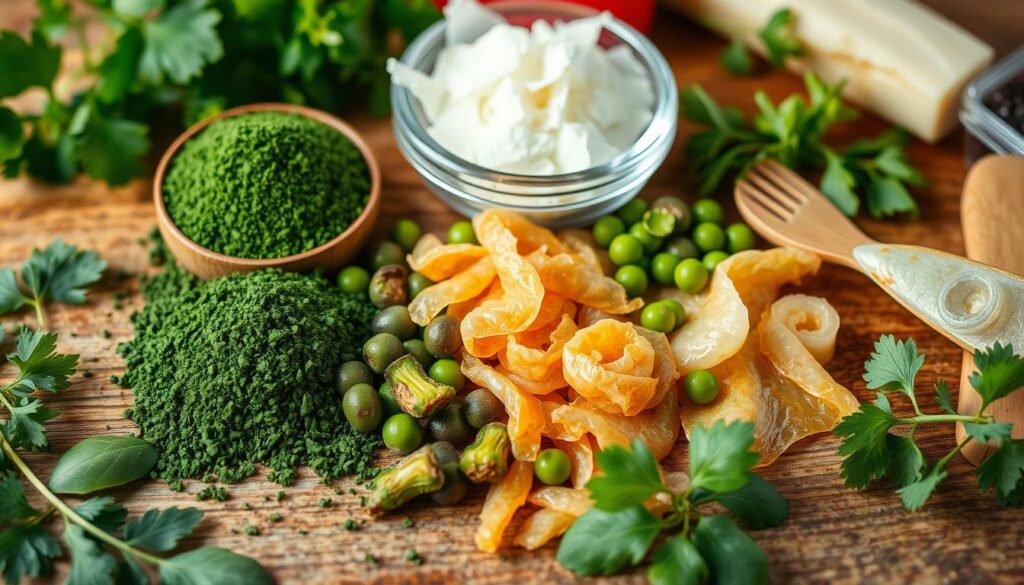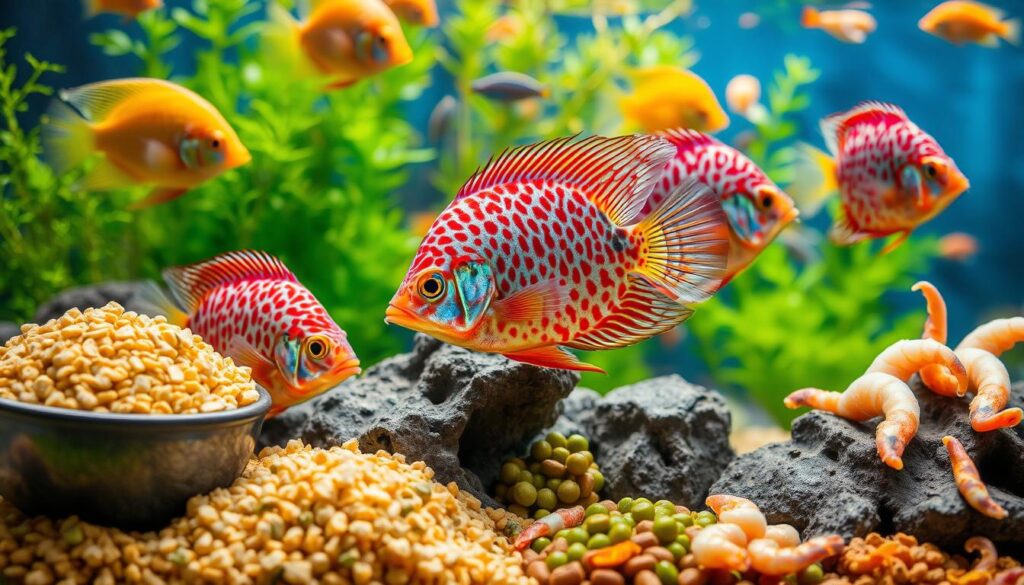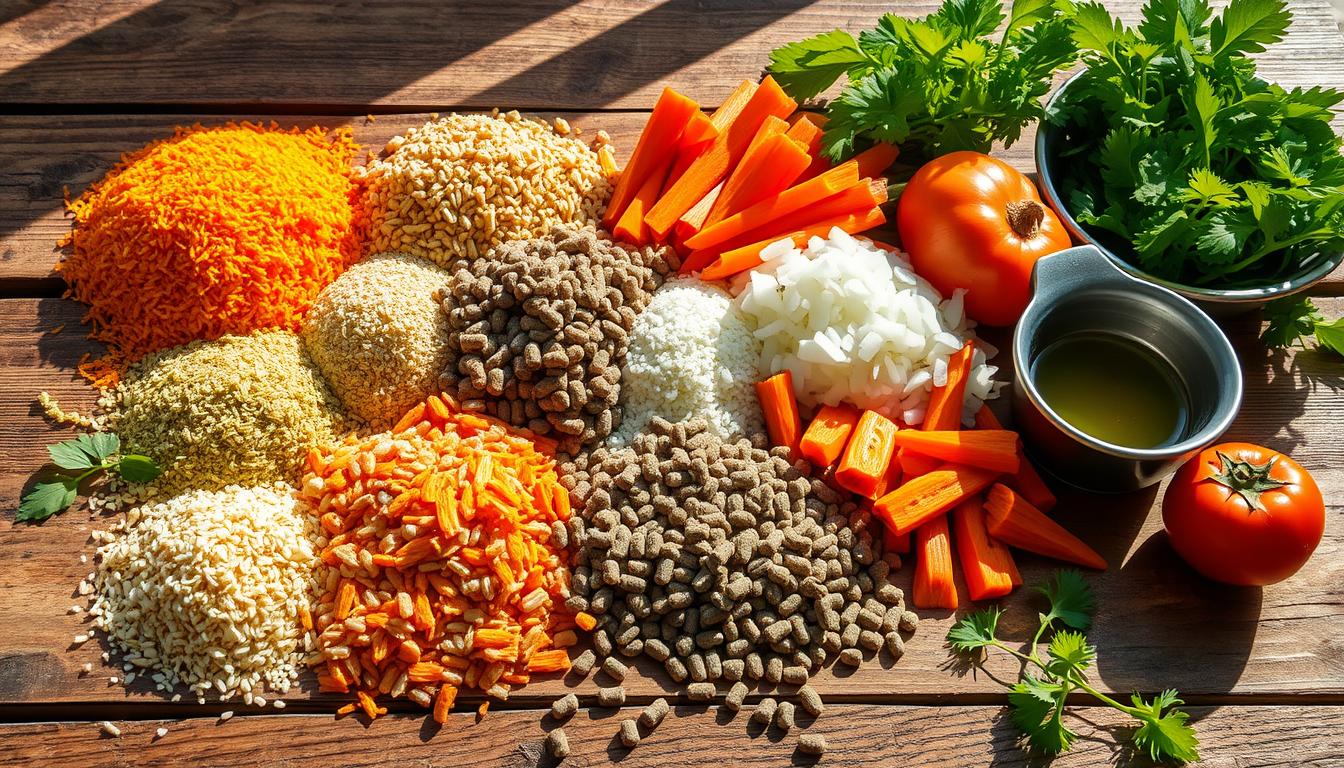We know how important it is to care for our fish. A great aquarium is more than clean water. It’s also about giving our fish the right food.
Homemade fish food is a great choice. It’s cheaper and lets you control what your fish eat, much like the customizable options in our Traditional German Recipes with Pear | Authentic Dishes. Unlike store-bought food, homemade food avoids bad ingredients.
By making your own fish food, you can meet your fish’s needs. Whether they like plants, meat, or both, you can make the perfect meal for them.
Key Takeaways
- Homemade fish food provides cost-effective, customized nutrition for your aquarium inhabitants.
- Understanding the dietary needs of different fish types is key for making the right homemade meals.
- Making your own fish food lets you avoid bad additives found in many store-bought foods.
- Homemade fish food recipes can be made to fit your aquarium’s needs.
- Preparing homemade fish food is a fun and money-saving thing to do for aquarium lovers.
Understanding Fish Nutrition Basics
It’s key to make sure fish get the right food to stay healthy. Knowing what different fish need helps us feed them well. Let’s look at the basics of fish nutrition and what they need to do well.
Types of Fish Dietary Requirements
Fish are divided into three groups: herbivores, omnivores, and carnivores. Herbivores, like goldfish, eat plants. Omnivores, such as guppies, eat both plants and animals, much like how dietary preferences vary in our Dessert & Juices collection. Carnivores, like bettas, need a lot of meat.
Essential Nutrients for Aquarium Fish
All fish need a mix of nutrients to stay healthy. They need proteins, vitamins, minerals, and fats. Proteins help them grow and repair. Vitamins and minerals boost their immune system and health. Fats give them energy and help with vitamin absorption.
The Importance of Varied Diet
It’s important to give fish a varied diet. This helps them get all the nutrients they need. A mix of dry, frozen, live, and fresh foods keeps them healthy. It also makes them happy and active in their tank.
| Nutrient Category | Examples | Importance |
|---|---|---|
| Proteins | Fish meal, shrimp, squid | Growth, tissue repair |
| Vitamins | Vitamin A, C, D, E, B-complex | Immune function, metabolism |
| Minerals | Calcium, phosphorus, iron | Bone and scale development, enzyme function |
| Fats | Omega-3 and omega-6 fatty acids | Energy, vitamin absorption |
Learning about fish nutrition helps us choose the best fish pellet recipe and tropical fish nutrition. This supports their health and happiness for a long time.
Best Ingredients for Homemade Fish Food
Choosing the right ingredients is key for homemade fish food. We’ve found the best options for your DIY fish feed and cichlid food mix.
Vegetables like spinach, kale, zucchini, broccoli, and carrots are great. They give vitamins and minerals to herbivorous and omnivorous fish. For protein, add fresh seafood like fish, shrimp, squid, and mussels. Garlic is also good for fish health.
Remember, different fish need different foods. Carnivores need more protein, while herbivores and omnivores like plants. Always remove fat from meat to avoid liver damage in fish.
| Ingredient | Benefits | Recommended for |
|---|---|---|
| Spinach, Kale, Zucchini, Broccoli, Carrots | Provides essential vitamins and minerals | Herbivores, Omnivores |
| Fish, Shrimp, Squid, Mussels | Offers a protein-rich source of nutrition | Carnivores, Omnivores |
| Garlic | Promotes overall fish health | All fish types |
By picking the right mix of veggies, proteins, and other good stuff, you can make food that fits your fish’s needs. This keeps them healthy and saves money on commercial food.
“Homemade fish food can be a game-changer for your aquarium, providing a customized and nutritious meal that your fish will love.”

Simple Fish Food Recipe for Beginners
Making homemade fish food is easy. You just need a few kitchen tools and simple ingredients. This recipe is great for both new and experienced aquarium owners.
Required Kitchen Equipment
- Kitchen scales for precise measurements
- Sharp chef’s knife for chopping vegetables
- Blender or food processor to puree ingredients
- Plastic wrap or airtight containers for storage
- Ice cube trays for freezing the fish food
Step-by-Step Preparation Guide
- Gather all the necessary ingredients, which may include spinach, cucumbers, peas, oatmeal, and gelatin.
- Thoroughly wash and chop the vegetables into small pieces.
- In a blender or food processor, puree the vegetables until they reach a smooth, uniform consistency.
- Prepare the gelatin according to the package instructions, ensuring it is completely dissolved.
- Combine the vegetable puree and the prepared gelatin, mixing well to create a homogeneous mixture.
- Pour the mixture into ice cube trays, allowing it to freeze completely.
Storage and Preservation Tips
After freezing, take the fish food cubes out of the trays and explore creative storage methods, similar to those used in our Frozen Fish Food Blend Guide. Store them in airtight containers or resealable bags in the freezer. This keeps the frozen fish food blend fresh for a long time. It ensures your fish get a steady, nutritious diet.
By using this simple recipe and storage tips, you can make a lot of high-quality, live food culture for your fish. Start making homemade fish food and see your fish thrive!
Advanced Protein-Rich Fish Food Recipe
Making homemade fish food is fun for aquarium fans. Our recipe is packed with protein for growing fish, like discus. It’s made with top ingredients for the best results.
Fresh salmon, raw shrimp, and gelatin are the main ingredients. We dice and blend them into a smooth paste. This makes a food rich in nutrients that fish can easily digest. We also add frozen peas, spinach, carrots, and a bit of garlic for extra nutrition.
Mixing the gelatin with the other ingredients is easy. Then, cook it on low heat for about 45 minutes. Once it cools, you can freeze it in ice cube trays for later use.
This recipe has over 55% protein by dry weight. It’s perfect for helping fish grow and stay healthy. It’s a great choice for your aquarium’s inhabitants.
| Ingredient | Protein Content |
|---|---|
| Salmon | 59% protein by dry weight |
| Raw Shrimp | Approximately 75-85% protein by dry weight |
| Frozen Peas | Approx. 5g protein per 100g |
| Spinach | Approx. 2.9g protein per 100g |
| Carrots | Approx. 0.9g protein per 100g |
By picking and mixing these protein-rich foods, we’ve made a top-notch fish food. It’s great for your aquarium’s health and growth. Adding this recipe to your discus diet can really help your fish thrive.

Vegetarian and Herbivore Fish Food Options
We need to feed our aquarium fish the right food. Herbivorous fish, like plecos, eat plants and algae. They need a diet rich in plants.
Plant-Based Ingredients Selection
For vegetarian fish food, we use plants. Good choices are:
- Spinach
- Cucumber
- Peas
- Oatmeal
These plants give fish the vitamins and fiber they need. We can also add a bit of fruit like apples. But watch the sugar.
Preparation Methods for Veggie Mix
Making veggie fish food is easy. First, blanch the veggies to make them soft. Then, blend them into a smooth mix.
Add oatmeal and a bit of gelatin to hold it together. Pour into molds and freeze. This makes a healthy food for your fish.
| Ingredient | Purpose |
|---|---|
| Spinach | Provides essential vitamins and minerals |
| Cucumber | Adds hydration and fiber |
| Peas | Rich in protein and complex carbohydrates |
| Oatmeal | Binds the ingredients and provides additional nutrients |
| Gelatin | Helps the mixture hold its shape and texture |
Using plants and following these steps, we can feed our fish well. This meets their aquarium fish diet and tropical fish nutrition needs.
Common Mistakes to Avoid When Making Fish Food
When making homemade fish food, there are mistakes to avoid. These ensure your fish stay healthy. Let’s look at these mistakes and how to make the best fish food recipe.
One big mistake is overfeeding. It’s key to feed the right amount and at the right time. Too much food can harm water quality and your fish’s health.
- Don’t add too much fat to your recipes. Too much fat can hurt water quality and fish health.
- Always remove uneaten food quickly to keep the water clean.
- Make sure to mix up your fish’s diet with different foods. A varied diet is important for their health.
Another mistake is using wild-caught earthworms. They might seem natural, but they can carry parasites. It’s safer to use captive-bred protein sources.
Be careful with gelatin in your fish food. Too much can harm water quality and your fish. Aim for a balance so your fish can eat it easily.
Also, chop or blend ingredients well to avoid choking hazards. This makes sure your fish can digest the food well, keeping them healthy.
By avoiding these mistakes, you can make tasty and healthy homemade fish food. Your fish will thank you! Bon appétit, little swimmers!
Conclusion
Making homemade fish food lets us tailor the nutrients for our fish. It’s cheaper and uses fresh, quality ingredients. But, it takes more time and effort than store-bought food.
When we make fish food at home, we must think about the fish’s needs and how to store it. DIY food has many benefits, but some people prefer store-bought for convenience. This is true for those with busy lives or when they’re away.
Choosing between homemade and store-bought fish food depends on what we prefer and our fish’s needs. By looking into fish food recipes and learning about fish nutrition, we can give our fish a healthy diet. This helps keep them happy and healthy.

